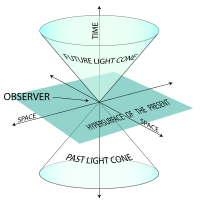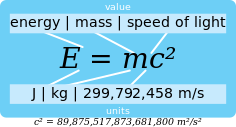تكافؤ الكتلة-الطاقة
| النسبية الخاصة |
|---|
 |
| الفيزياء |
|---|
| تاريخ الفيزياء |
In physics, mass–energy equivalence is the principle that anything having mass has an equivalent amount of energy and vice versa, with these fundamental quantities directly relating to one another by Albert Einstein's famous formula:[1]
ط=ك.س²
هذا المبدأ الفيزيائي الذي أطلقه ألبرت أينشتاين ، يعبر عن أن حاصل ضرب الكتلة في مربع سرعة الجسم ، يساوي إلى طاقته.
أو
Here the term represents the square of the Euclidean norm (total vector length) of the various momentum vectors in the system, which reduces to the square of the simple momentum magnitude, if only a single particle is considered. This equation reduces to when the momentum term is zero. For photons where , the equation reduces to .
معاني الصيغة الصارمة

خلفية
علاقة الكتلة-السرعة
In developing special relativity, Einstein found that the kinetic energy of a moving body is
with v the velocity, m0 the rest mass, and γ the Lorentz factor.
He included the second term on the right to make sure that for small velocities the energy would be the same as in classical mechanics, thus satisfying the correspondence principle:
Without this second term, there would be an additional contribution in the energy when the particle is not moving.
Einstein found that the total momentum of a moving particle is:
It is this quantity that is conserved in collisions. The ratio of the momentum to the velocity is the relativistic mass, m.
And the relativistic mass and the relativistic kinetic energy are related by the formula:
Einstein wanted to omit the unnatural second term on the right-hand side, whose only purpose is to make the energy at rest zero, and to declare that the particle has a total energy, which obeys:
which is a sum of the rest energy m0c2 and the kinetic energy. This total energy is mathematically more elegant, and fits better with the momentum in relativity. But to come to this conclusion, Einstein needed to think carefully about collisions. This expression for the energy implied that matter at rest has a huge amount of energy, and it is not clear whether this energy is physically real, or just a mathematical artifact with no physical meaning.
In a collision process where all the rest-masses are the same at the beginning as at the end, either expression for the energy is conserved. The two expressions only differ by a constant that is the same at the beginning and at the end of the collision. Still, by analyzing the situation where particles are thrown off a heavy central particle, it is easy to see that the inertia of the central particle is reduced by the total energy emitted. This allowed Einstein to conclude that the inertia of a heavy particle is increased or diminished according to the energy it absorbs or emits.
الكتلة النسبية
انظر أيضاً
المراجع
- ^ خطأ استشهاد: وسم
<ref>غير صحيح؛ لا نص تم توفيره للمراجع المسماةfamous
وصلات خارجية
- Einstein on the Inertia of Energy – MathPages
- Lasky, Ronald C. (April 23, 2007), What is the significance of E = mc2? And what does it mean?, Scientific American, http://www.sciam.com/article.cfm?id=significance-e-mc-2-means
- Mass and Energy – Conversations About Science with Theoretical Physicist Matt Strassler
- Ask an Astrophysicist | Energy–Matter Conversion, NASA, 1997
- The Equivalence of Mass and Energy – Entry in the Stanford Encyclopedia of Philosophy
- Gail Wilson (May 2014) Scientists discover how to turn light into matter after 80-year quest Imperial College
- Merrifield, Michael; Copeland, Ed; Bowley, Roger. "E=mc2 – Mass–Energy Equivalence". Sixty Symbols. Brady Haran for the University of Nottingham.
- Hecht, Eugene (2009). "Einstein on mass and energy". American Journal of Physics. 77 (9): 799–806. Bibcode:2009AmJPh..77..799H. CiteSeerX 10.1.1.205.7995. doi:10.1119/1.3160671.
Early on, Einstein embraced the idea of a speed-dependent mass but changed his mind in 1906 and thereafter carefully avoided that notion entirely. He shunned, and explicitly rejected, what later came to be known as 'relativistic mass'. ... He consistently related the rest energy of a system to its invariant inertial mass.
















